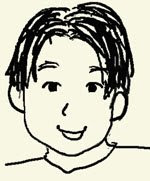Each of Learning Patterns is written in the format which consists of following items; "Pattern Number", "Pattern Name", "Introduction", "Illustration", "Context", "Problem", "Forces", "Solution", "Actions", "Related Patterns." Especially in the catalog of learning patterns, each pattern is printed in a double-page spread, which is handed out for university student as I will mention later.
In the first half of pattern, which is printed at the left page in the catalog, the overview of the pattern is described.
At first, Pattern Number is sequential number. Pattern Name is named as attractive and memorable phrase.
Next, Introduction and Illustration is provided in order to help for the reader to imagine the meaning of the pattern lively.
Then, there is a list of when the reader can use the pattern as Context. The reader can search his/her necessary pattern from his/her context with using the context navigation.
In the last half of pattern, which is printed at the right page in the catalog, the detail of the pattern is described. At first, Problem which is often occurred is described.
Problem is emphasized in bold type. In succession to Problem, Forces are written as laws which are not able to or difficult to be changed. The difficulty to solve the problem comes from the existence of these forces, because your solution needs to meet all of them. After the Forces, the separator  is placed.
is placed.
 is placed.
is placed.Next, Solution is written in bold type. Then, in the part of Actions, more concrete advice like examples or alternatives is introduced. After the Actions, the separator  is placed again.
is placed again.
 is placed again.
is placed again.At the last, Related Patterns are provided. Good learning is effectively achieved by combining some patterns. The reader can understand the meaning of the pattern deeper through reading the section of Related Patterns.


this is really interesting. how can we get a copy of the entire catalog of 40?
ReplyDelete